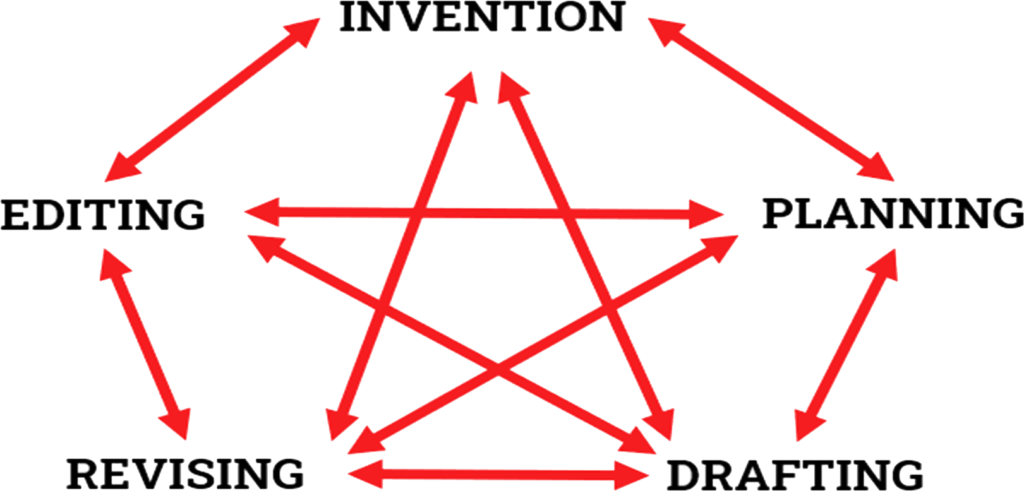chapter 9: writing and grammar
To understand the basics for applying grammatical concepts to the writing that you do every day, you need to begin with a clear understanding of your own writing process and how an understanding of grammatical concepts can help you develop effective strategies for editing that writing.
To begin, recall the model for the writing process:

As we described in the introduction, we will not consider grammar as a part of invention, planning, or drafting. Instead we will examine the role grammar might play in the revision and editing stages of the writing process. While revision and editing are part of the larger writing process, each of these components can be thought of as a process in and of itself. As part of your development for understanding and applying grammatical concepts to the writing that you do every day, this page describes strategies that grow out of the study of language in the context of writing and writing instruction.
To critically review a document effectively, we want to build on a method of “top-down” editing developed by Dr. Patricia Sullivan at Purdue University. For our purposes, and to stay consistent with our approach in this textbook, we have reconfigured it slightly as a revision flowchart. But the method itself clearly comes from Dr. Sullivan’s original idea.
This revision flowchart provides a structured routine for inspecting documents in a more comprehensive manner. The goal of the process is to assist you in both identifying and fixing problems in the text that are most likely to interfere with a reader’s comprehension. Graphically, the revision flowchart looks like this:

To perform top-down editing, as this flowchart indicates,
- Attend to the document-level problems first
- Work on the section-level problems second
- Reshape the paragraph-level issues and address sentence-level problems third
- Check for transitions between sections and overall context-making
- Do a final proofreading pass
In general, reviewing your writing can be approached on the different levels at which the document can be improved.
- Revision = re-vision = addressing changes at the global level = higher-order concerns
- Editing = addressing changes at the surface level (sentence, phrase, word) = lower-order concerns
- Proofreading = making changes to spelling and punctuation = always the last, separate step.
When revising and editing your paper, not every element of your work should have equal priority. The most important parts of your paper—often called “Higher-Order Concerns”—are the “big picture” elements. After you have addressed these more important elements, you can turn your attention to the “Lower-Order Concerns,” which include grammatical concepts and punctuation.
We will not review higher-order concern strategies, but will focus here on how you can more effectively examine a text at the editing stage for lower-order concerns, which primarily include:
- Sentence Patterns
- Linguistic Style
- Sentence Structure
- Punctuation
- Word Choice
- Pronouns
- Transitional Words
- Spelling

At the editing stage, you begin by checking that your information is arranged appropriately and that sentence constructions do not pose a barrier to your reader understanding the message. Your initial review at this stage should begin with the following goals:
- Ensure that paragraphs highlight main idea and are logically ordered
- Ensure that sentences are varied
- Ensure that sentences are clear and concise
To meet these editing goals, you should first develop paragraph-level strategies to ensure that
- each paragraph connects to the main point
- the topic of the paragraph is the subject of most sentences in that paragraph

Second, develop sentence-level editing strategies for
- appropriate use of sentence variety, based on an understanding of genre, purpose, and audience
- rhetorically sound and consistent use of the active and passive
- accurate and consistent use of punctuation
- avoidance of sentence fragments and dangling or misplaced modifiers
- appropriate use of the main verb phrase
This should include a close read for generally sloppy mistakes, such as
- non-parallel structures
- gratuitous repetition
- inconsistent reference to terms/people/ideas
- misspellings
Third, develop proofreading strategies as a final review before submission. The key is to find one that you are comfortable with, such as
- Review once in reverse, from end to beginning, line by line, focusing on punctuation
- Scan the whole text for one or two issues at a time (requires re-reading several times)
- Review whole text for known problem areas first
- Read aloud to identify subject-verb disagreement, non-parallel constructions, choppy sentences, sentence fragments
- Review in chunks, by section or by paragraph, with breaks in between
- Proofread a hard copy, not on screen

In short, you should set extra time aside to edit effectively. As you consider the concepts described in this textbook, you should begin to develop and apply strategies for editing your writing in the future.
Finally, we want to emphasize that these editing strategies should be applied at the END of the process, and only AFTER you have attended to the higher-order concerns, which should begin with general considerations:
- Making context and purposes explicit
- Highlighting conclusions and major evidence
- Providing visual and verbal roadmaps for readers
- Meeting reader’s needs/expectations for this type of document
and then focus your higher-order review more specifically on
- Thesis or focus
- Audience and purpose
- Organization
- Development
- Coherence
- Repetition of a Key Term or Phrase
The overall strength of your writing will always be your ability to articulate your purpose clearly, offer a coherent argument, provide appropriate and necessary support for your claims, and connect to your readers in both explicit and implicit ways. Understanding grammatical concepts can help make your writing appear better, but grammatically correct and perfectly punctuated sentences alone will not make a good piece of writing.

